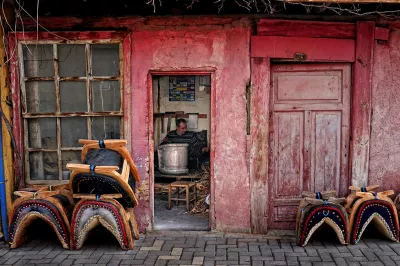Payment Innovations in Turkey: Not (Yet) Reaching the Unbanked
Undoubtedly, Turkey has a lot to offer when it comes to its payment system, which is typical for countries that have experienced sustained periods of inflation and therefore put a premium on the efficiency of its payments infrastructure. Yet it is much less obvious whether the prevailing models will also contribute much to digital financial inclusion, as they often suffer from challenges in customer adoption and therefore reach only a minority of the population.
As mentioned in our first blog in this series, 43% of adults generally and a disappointing 55% of female adults lack access to an account at a formal financial institution, so even if most people might have a financial access point close by, many of them still lack an account to transact through. The question is whether innovations in the payments sphere can contribute to closing this gap.

Photo credit: Yavuz Sariyildiz/2012 CGAP Photo Contest
The majority of payment innovations make use of what is already there – branches (including postal branches), ATMs, and an impressive number of credit and debit cards. (With 43% debit card penetration, for example, the majority of bank account holders also has a debit card). Most are targeted at increasing the convenience for existing customers or lowering the cost of delivery. Examples include models that link customers’ debit or credit cards to digital wallets to facilitate payments and transfers, or mobile financial services that can only be used on smartphones, which are often not accessible to underserved customers. Further complicating matters is a regulation that prevents banks (with the exception of PTTBank) from building agent networks – cash-in and cash-out services are only permitted at ATMs and branches. Some smaller banks such as ABank are cooperating with the PTTBank to make use of its large branch network for the delivery of their services, but this is only possible because of the PTTBank’s special legal status. Changing this regulation and permitting banks to use agents could create new opportunities for banks to reach out to poorer customers without the high costs associated with branches.
However, there are a few innovations that have the potential to move beyond the current reach of bank accounts and cards:
Moving agricultural loans to digital: The state-owned Ziraat Bank as the main lender to the agricultural sector offers a Visa-branded debit card for farmers (with many of whom are otherwise unbanked), which is used to issue loans below $40,000. Loans are issued to the card account, and the cards can then be used for purchases, cash withdrawals, and loan repayments at one of 5,700 Ziraat ATMs or one of 1,650 Ziraat branches. To guarantee that loan funds are primarily used for agricultural purposes, the cards have limits for cash withdrawals with the remaining balance only to be used for purchases at the bank’s extensive merchant network of about 300,000 suppliers that are equipped with POS terminals for cashless payments.
Prepaid cards linked to mobile phones: A number of prepaid card programs have been launched such as cep nakit (“pocket cash”) issued by ING Bank and offered at PTTBank branches that can be used for payments and transfers. While ING is the main bank partner, the card carries the brand of PTTBank and Vodafone as the two other partners in this. The card can be purchased at one of 1,300 Vodafone offices or 4,500 PTT branches and can also be loaded at these plus 1,800 PTTBank ATMs. Withdrawals are possible at any ATM (for free only at PTT ATMs) and PTT branches.
Another example is Turkcell, the largest mobile operator in Turkey, which offers a prepaid card linked to a mobile number called Cep-T Paracard in cooperation with Akbank and Garanti Bank. The MasterCard-branded card can be purchased at one of 1,200 Turkcell dealers or at bank branches and be used for transfers, bill payments, and merchant payments.
Domestic remittances via ATMs: A couple of banks have launched domestic remittance products. These products enable people to send money anywhere in the country, even to non-account holders, for withdrawals at ATMs on receipt of a confirmation code that is sent to the recipient’s mobile phone. Garanti Bank even permits non-customers to send money by depositing it at an ATM, from where it is sent to someone else for withdrawal at any Garanti Bank ATM.
To date very little information is available about the take up of any of these products, and none of these are explicitly marketed toward unserved and underserved market segments. The Turkish G20 presidency and its focus on financial inclusion could be a unique opportunity to raise Turkish providers’ (banks’, mobile operators’, and payment service providers’) awareness of opportunities to contribute to digital financial inclusion.
A recent enabling regulatory change is the adoption of a dedicated payments law in 2013 and the issuance of its implementing regulations in June 2014. The law has created two new types of licensing categories referred to as payment institutions and electronic money institutions, which are authorized to provide payment services and issue electronic money, respectively. Both types of institutions will come under direct supervision by the Banking Regulation and Supervision Authority. Electronic money institutions are more promising from a financial inclusion perspective, as they allow customers to open electronic wallets as an alternative to traditional bank accounts. It is still too early to tell what the impact of this law on the sector will be with the deadline to apply just recently having passed (27 June 2015). An impressive number of approximately 30 institutions have already applied, but no license has been issued yet.
Moving forward, payments innovations and in particular the emergence of directly licensed electronic money institutions will be a trend to watch in Turkey. What financial inclusion progress will we see in the next Global Findex? Any changes in the digital finance space could be a powerful determinant.



Add new comment